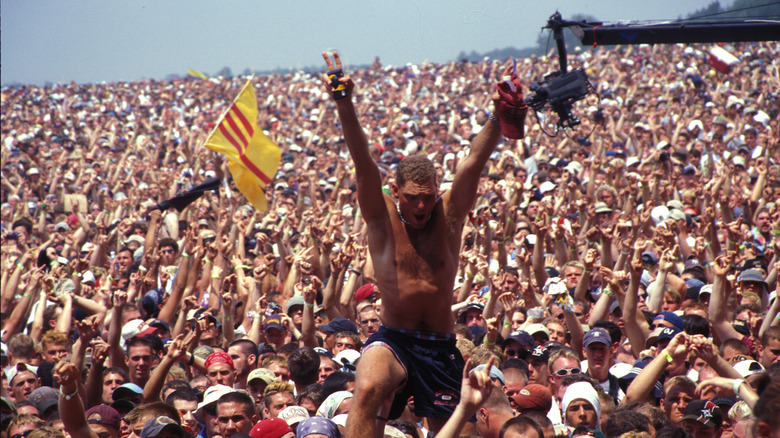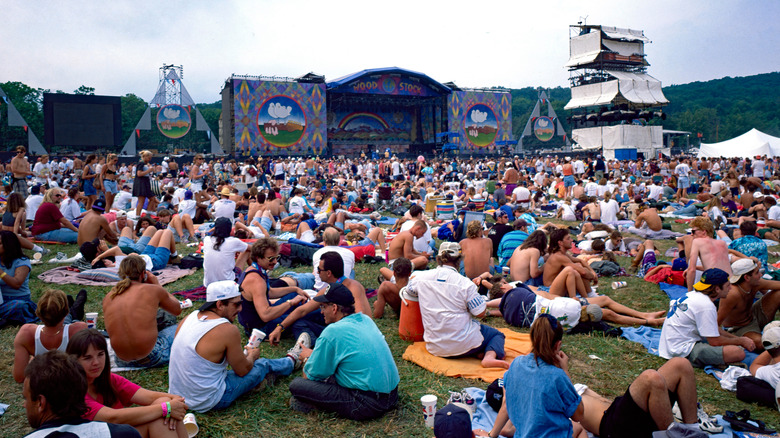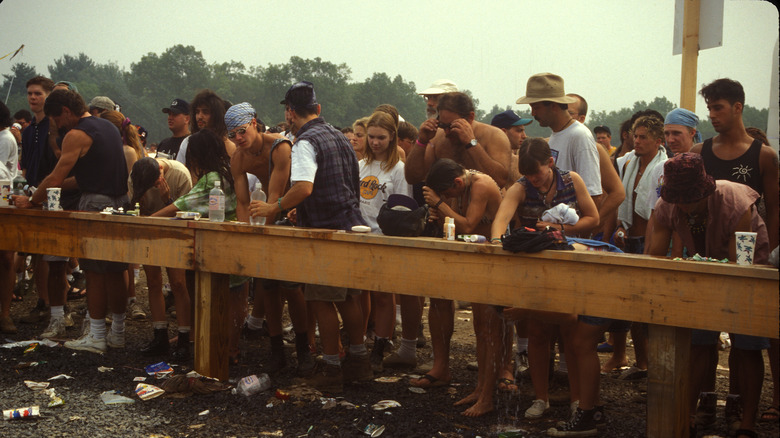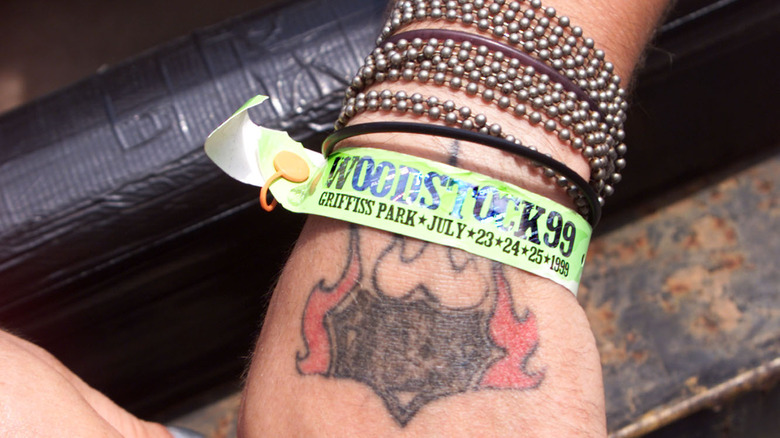Woodstock 99: How Much Money The Controversial Festival Probably Made
With iconic performances from Santana, The Grateful Dead, The Who, and Janis Joplin, the original Woodstock 1969, held on farmland belonging to a man named Max Yasgur in Bethel, New York would go down in history as one of the best music festivals of all time (via History). As a rather makeshift festival, concession stands, bathrooms, and medical facilities were still being put up when the guests started to arrive, according to History. Although the organizers were only expecting 50,000 people, it's been estimated that close to one million attended the iconic 1969 festival (via History). With people literally storming the gates, organizers decided to throw in the towel in the most "peace and love" way possible: making the festival free.
Naturally, people tried to recreate the 1969 festival in 1999, but the controversial festival — in which attendees got the infamous infection from World War I called trench mouth because there was so little access to clean water — fell short of mimicking the original. Yet unlike the first Woodstock, which didn't actually turn a profit, the 1999 Woodstock made a fortune (via Women's Health Magazine).
Another revamp
In light of a newly released documentary about the 1999 festival, filmmakers take a closer look at the "trainwreck" that was the follow-up festival. According to Women's Health Magazine, this attempt lacked the peacefulness of the original and there were plenty of messed up things that happened at Woodstock '99, including widespread crimes, violence, and even death.
Woodstock organizer Michael Lang, who recently died with a net worth of about $10 million, had tried to revamp the iconic 1969 festival once before in 1994, according to NPR. Hosted on Winston Farm just north of Saugerties, New York, tickets for the first follow-up festival cost $135 — roughly seven times the price of the original's $18 three-day pass — would get you access to see bands like Aphex Twin, Bob Dylan, Green Day, and Aerosmith, according to New York State Music. MTV covered the event, which was full of mud, "positive memories, crazy rumors, and great music" unlike the soon-to-follow 1999 flop, per New York State Music. (And don't even ask what was actually in the mud at Woodstock '99.)
Fire-burning riots
Fast-forward another five years, and Lang tried to host another Woodstock — but maybe he should have quit while he was ahead. Hosted in a decommissioned air force base in Rome, New York, the festival was equipped with concrete bunkers to prevent people from getting in without buying tickets — which cost more than $150 a pop, according to Women's Health Magazine. With temperatures over 100 degrees, one of the darkest moments of Woodstock '99 was when a 24-year-old died from heat-related illness, per MTV, and he wasn't the only person to die — another attendee was hit by a car outside the festival and a third man died from cardiac arrest on the campgrounds. Other horrors happened when women were sexually assaulted, according to Rolling Stone.
Additionally, an audio tower caught fire during the Red Hot Chili Peppers' set, and there were limited supplies of food and water, which was polluted and led some people to contract trench mouth from the bacteria in it, according to New York State Music. Perhaps because of the heat, high prices, the lineup, and other factors, there were also riots that broke out on the festival campgrounds.
'Profitstock' cashing in
According to NME, Woodstock '99 was nicknamed "Profitstock" because it was clear that the organizers were only focused on making money. With ticket sales alone, the organizers were thought to have gained $60 million, although damages endured from the riots were estimated to have cost organizers millions of dollars and the festival probably cost close to $40 million to put together, according to The Huffington Post. Organizers price-gouged attendees in a style that is likely familiar to many who attend festivals and sporting events these days, with a bottle of water costing about $4 (more than $7 in 2022 when adjusted for inflation), a personal pizza costing $12 (that's more than $21 in 2022), and food booths making upwards of $70,000, ($124,500 in 2022 when adjusted for inflation) according to Syracuse.com and The Huffington Post.
Needless to say, the reboot was a far cry from the "peace and love" vibes of the original 1969 Woodstock. In a 1999 article reviewing the festival, SFGate called it "the day the music died" that was "one of the biggest debacles in concert history." Maybe that's what happens when profit replaces peace and love as the heart of a festival.



